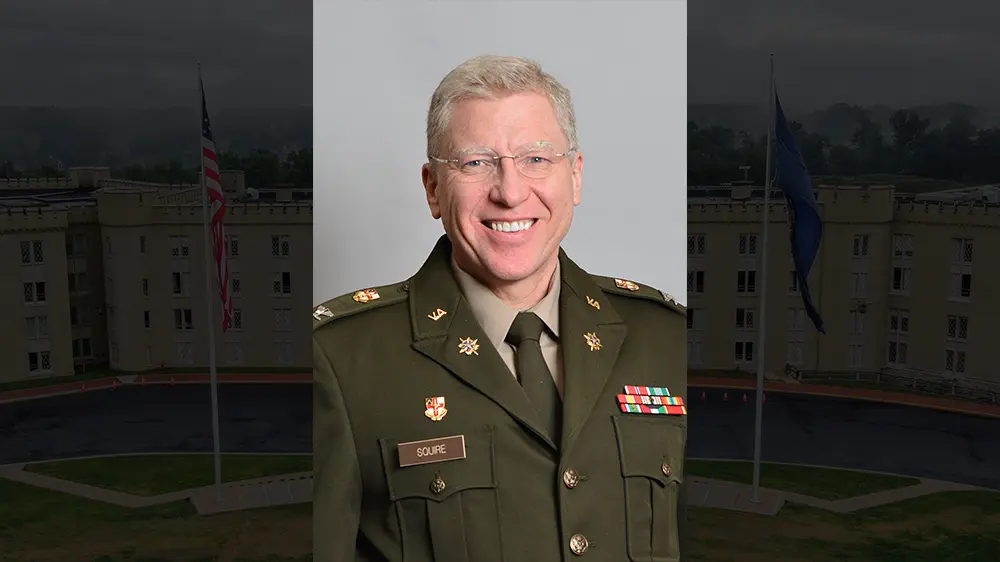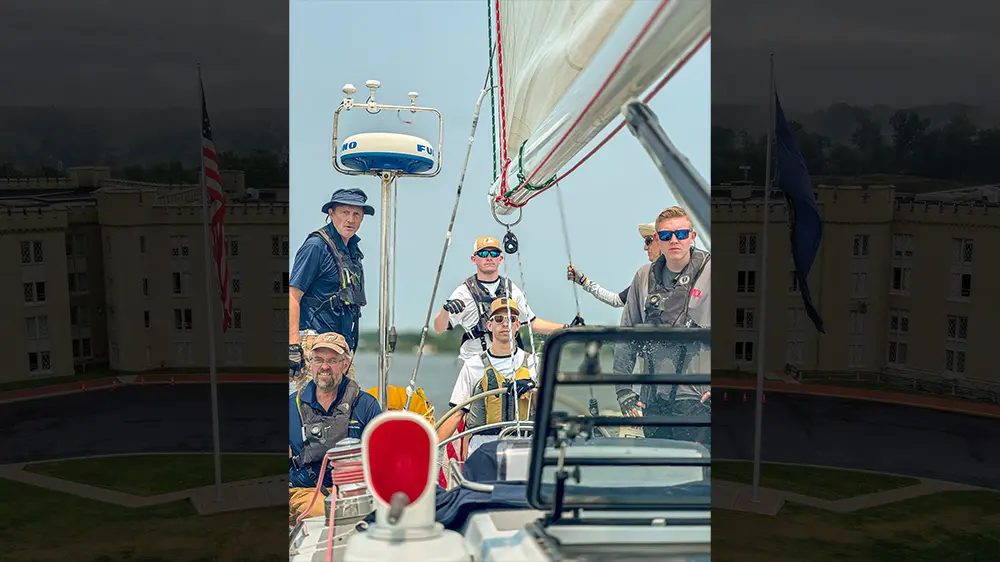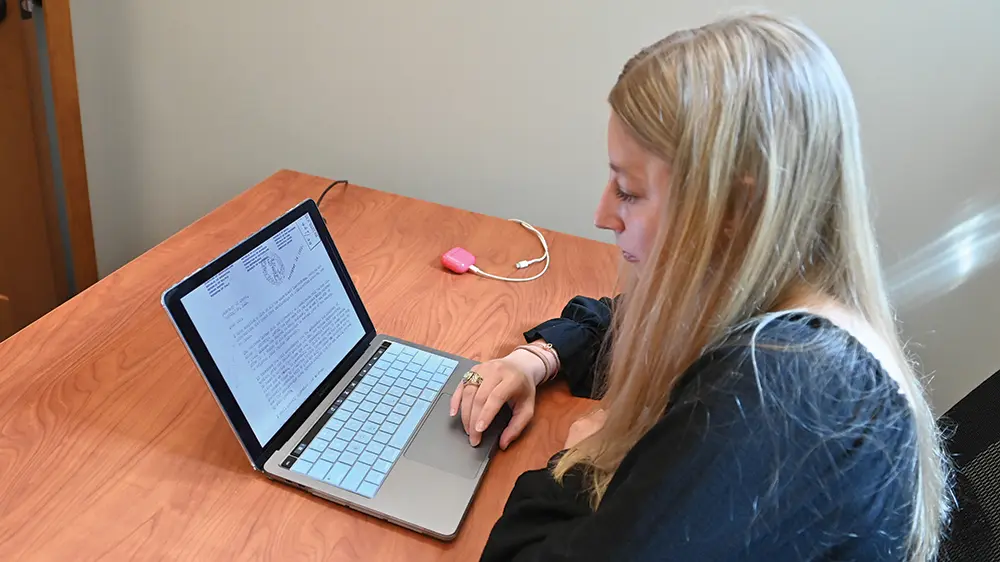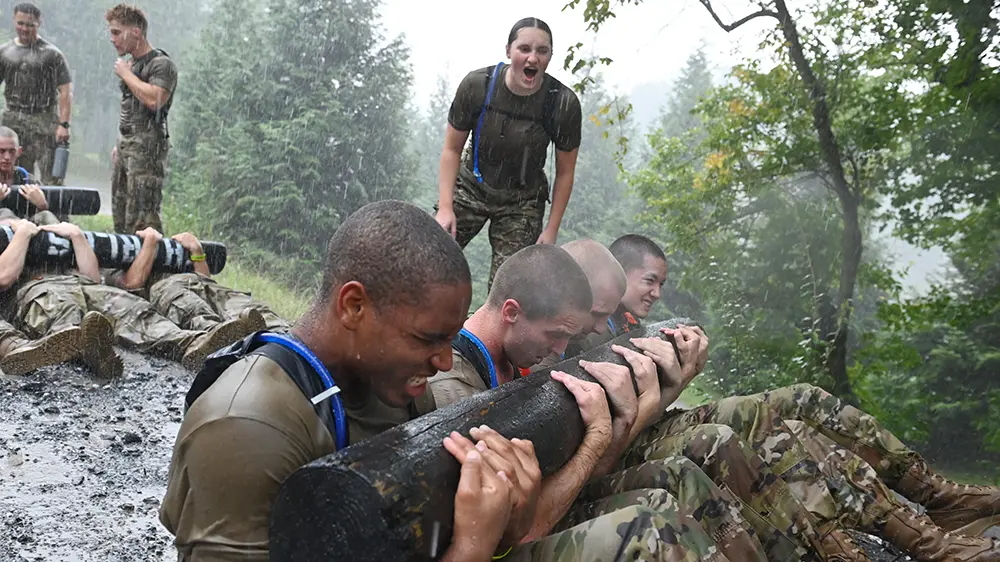Col. James C. Squire, Ph.D., P.E., is the Jamison-Payne Professor in the Department of Electrical and Computer Engineering.
A 1989 U.S. Military Academy graduate, he was a military intelligence officer and received the Bronze Star during Operation Desert Storm. He received his doctorate from the Massachusetts Institute of Technology and came to VMI in 1999.
The first-named inventor of eight patents, Squire has published more than 50 papers and authored two textbooks. He also co-founded three high-technology startups.
He has received numerous awards for teaching, research, and mentorship and is the only professor in Virginia to have received two awards from the State Council of Higher Education for Virginia: A Rising Star in 2004 and Outstanding Faculty in 2025.
Q: What attracted you to teaching? Why VMI?
A: I cycled through many different professions before VMI. I served as a military intelligence officer after I graduated from West Point, then I taught at an inner city Christian high school in New Jersey. While I earned my doctorate in biomedical engineering at MIT, I worked for a medical device implant company, and then in patent litigation as an expert witness. When my wife and I determined we wanted to raise a family, I knew that I had to pick one job. But I really liked doing different things. I realized that working principally as a small-town professor would let me continue to develop different interests without need to subspecialize. My background at West Point and in the Army made VMI a natural fit.
Q: What are some satisfying things about teaching at VMI?
A: MIT offered me a tenure-track position when I graduated, but I turned it down. I enjoy teaching undergraduate students far more than graduate students. Graduate students are already fairly developed as people. Give them lab space and a funding line, and they’ll produce good work. Undergrads still need supportive guidance and direction. They also develop rapidly and multi-dimensionally in 4 years. It is very special to play a role in that—and to do so in the context of a military school.
Q: You’ve helped cadets with several “hands-on” research projects, in which they have designed, developed, and built such things as the tick rover, a seismic communications device, and rockets. What benefits do cadets—and you—derive from these experiences?
A: I wouldn’t characterize any of them as “hands-on research projects.” They are simply “doing engineering.” Engineering’s raison d’être is to improve society through technology. Some of it can be taught in a traditional classroom setting, but most of it can only be taught in laboratories or machine shops. Prior to the 19th century, engineering was taught exclusively within a master-apprentice relationship. It moved to a traditional university degree only after enough calculus became so interwoven with design that classes were required. But it is still a technical degree, and so requires students to design, build, and test equipment. That’s what we do at VMI.
The ability to go from an idea to a real-world implementation is rewarding to cadets, whether that results in a patent, as it did for the tick rover (20 copies of which are currently collecting data for the CDC throughout the Northeast) or as happened for the seismic mine communicator, or in VMI’s fourth-place finish at a national-level rocket/robot competition. Many of these projects are interdisciplinary with the other engineering departments; Col. Jay Sullivan, Ph.D., the head of mechanical engineering, worked with me, my cadets, and his [cadets] on the first two projects named. Plus, building a 12-foot rocket powered by an engine that develops 500 pounds of thrust is simply cool, full stop.
Q: In the time you have been here you’ve witnessed many changes. What is something that stands out?
A: The radically improved infrastructure. When I started teaching, cadets and I would get splinters in our trousers from brushing past the plywood lab tables made by Physical Plant. Often, I’d move classes to the library because Nichols Engineering Building had no air conditioning until 2005, and classroom temperatures could easily break 90°F. Gen. Peay’s [’62, VMI’s 14th superintendent] ability to get state funding for renovations to Nichols made a massive difference, and Maj. Gen. Wins [’85, VMI’s 15th superintendent] did the same by securing money for a forthcoming renovation.
Q: What about VMI might surprise people?
A: People rightly expect cadets to have excellent time management skills, the ability to handle pressure, and leadership experience. What surprises many people is how well cadets’ technical skills match up head-to-head with better-known research universities’ undergraduates. They do so because VMI’s core mission is to teach. Professors at larger universities earn tenure based on how many grants they bring in or how many top-level journal articles they write, not how well they teach their undergraduates. So, they concentrate on building relationships with graduate students in the lab but not by working one-on-one with undergraduates—that is left to graduate student teaching assistants. Laboratory work is inherently one-on-one, unlike the one-on-many experience of a large lecture hall. So, teaching institutions like VMI offer more of the critical lab learning experience, and the benefits are obvious. One example: Until relatively recently, VMI competed against Virginia Tech in the annual Institute of Electrical and Electronic Engineers robot-building hardware challenge. In the final decade of competition, VMI won 9 out of 10 contests, until finally Virginia Tech refused to compete further. This is not because VMI students or faculty are inherently more talented than their peers at Virgina Tech; it is because the core mission of the two schools [is] different.
Q: If someone asked you why they should teach at VMI, how would you answer?
A: Simple: The Honor Code, which creates an environment that is strongly conducive to learning. When I give major tests, I leave two trays in the room: One for completed tests and one containing copies of the solutions. The cadets can immediately compare their answers with the solutions, which is important pedagogically—they would otherwise forget all the minor issues in the week it takes to grade and return the exams. This helped sell me on VMI. During my interview in 1999, I saw a $5 bill taped to a wall in Nichols and asked a cadet about it. He looked at me as if the answer was obvious: Someone found the bill on the floor and reasoned that whoever lost it would retrace his steps and find it there. What a difference from my experience at MIT, where even my lab’s water cooler was stolen multiple times—and sometimes in the middle of the day.
Department of Electrical and Computer Engineering
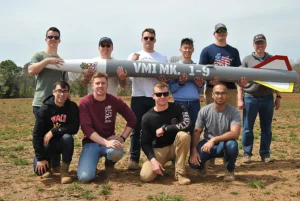
Col. James Squire, Ph.D., with a group of his cadets and their rocket.—Photo courtesy Squire.
Location: Nichols Engineering Building, 5th Floor
Department Head: Col. Shawn Addington, Ph.D.
Majors: 50-60 cadets major in electrical and computer engineering each year, and 12-14 cadets receive a degree.
Faculty: Six full-time faculty, boasting an 11-1 cadet-to-faculty ratio
Degrees: Cadets receive a Bachelor of Science degree in electrical and computer engineering, and they can pursue a minor in computer engineering.
Professorships: The Jamison-Payne Professorship, which is currently held by Col. James C. Squire, Ph.D. The department is also supported by an endowed fund.
Scholarships: Seven scholarships are available exclusively for cadets majoring in ECE. In academic year 2025–26, they will generate almost $47,000 in financial aid.
Hands-on: Almost all courses include significant laboratory experiences. The department also maintains a separate capstone facility to support senior design projects.
Equipment: Includes 3-D printing and laser cutting equipment, as well as facilities related to semiconductor device fabrication and characterization and advanced electronics packaging.
-

Scott Belliveau '83 Communications Officer - Executive Projects
The communications officer supports the strategy for all communications, including web content, public relations messages and collateral pieces in order to articulate and promote the mission of the VMI Alumni Agencies and promote philanthropy among varied constituencies.

